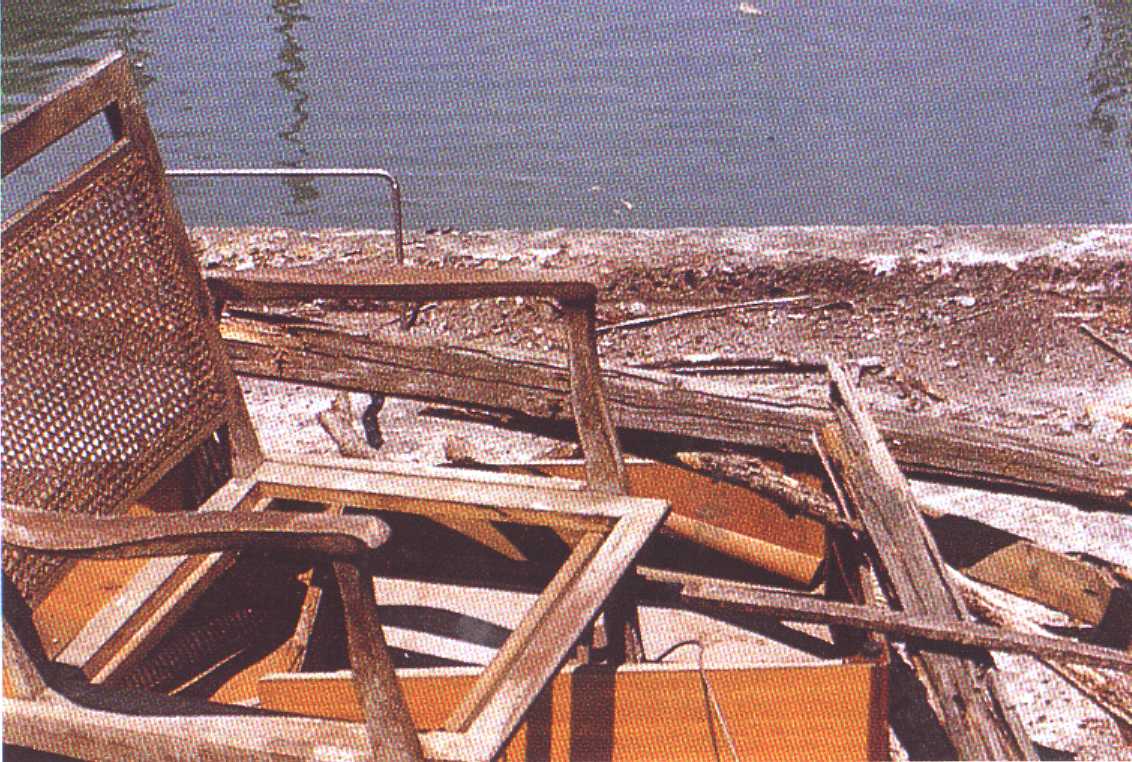桃園地區灌排水路受農工廢棄物污染現況之調查及其再回收利用可能性之研究
- Plan Name
- A Study on the Situation Survey and the Potential Uses For Irrigation System Polluted by Agro-Industry Bio一Fiber Wastes in Taoyuan Area
- 計畫編號
- 86-4-03
- 類別
- 農業環境保育類
- 摘要
- 灌排水路其污染種類以家庭廢棄物佔問卷總數90%之多,其次是塑膠佔85%,而木質材料、漂流木、舊家具等農林纖維廢棄物中,以舊家具的污染較常見佔53%之多;而以工廠廢棄物的污染較少佔32%。在灌排水路,其污染的季節,依農林纖維廢棄物、塑膠、工廠廢棄物、家庭廢棄物等分類,其污染嚴重的季節主要是在夏季和冬季,以夏季和冬季一般消費的情形而言,亦是以夏季和冬季的消費量為大,一般商家會以促銷增加買氣,因在夏天天氣變熱,添購冷氣或其他物質的情況增加,而冬季遇到傳統的過年,一般家庭會有除舊佈新或重新整頓打掃的習俗就會將家中不要的多餘的物品清理出來丟棄以致增加了污染源。農林纖維回收使用為室內用材的接受度不若作為外用材接受度高,其原因對這些產品多未見實際回收製成的產品,填卷人多只能以想像的方式填卷,故多數能接受室外用,但對於要用在室內使用,在心理上的接受較差。問卷中,建議事項為木質材料建立回收系統,認為需建立起回收系統,但對於使用者付費的收費方式與標準仍須評估及建立收費標準。以工廠之利樂包、竹材、木材等廢料回收後,加以清理,搗切成粒片,以尿素膠做膠合劑,用膠量10%(絕乾粒片重),在溫度15O°C、熱壓時間3min.、熱壓壓力3Okgf/cm2的條件下,預定製造板密度0.7g/cm3,試材尺寸45x45xl.5(cm)製成粗片板後測定其板材的密度、含水率、吸水厚度膨脹率、靜曲強度、內聚力、木螺絲保持力等性質,以評估板材之使用性。以現場回收之木質纖維廢棄物,以回收清理過程污染較大,需注意。製成板材之性質,以腐朽材性質較差,只符合CNS2215之l00型要求。其他由棧板廢棄物、室內裝潢廢棄物回收之木質纖維製成的板材性質與強度皆可達150型之要求。 水泥添加鋁粉與回收木質纖維結合之可行性,鋁粉添加量為水泥量之2/1000,其發泡速度過快,不易操作。鋁粉添加量為水泥量之1/1000,其發泡量大,使水泥與木材的結合鬆垮,強度降低許多。鋁粉添加量為水泥量之0.5/1000,其發泡量適中,強度降低較少。因凝結時間過長,使用鋁系之速凝劑以添加冰泥量之2/100之強度下降多,但凝結時間較1/100之添加量快;添加水泥量之1/100之速凝劑強度較佳;添加水泥量之0.5/100之速凝劑其凝結時間並無明顯之縮短。
- Abstract
- From the questionnaire survey, it showed 90% pollution as house wastes and 85% as plastic wastes, all were wastes pollution. There are 53% old furniture and 32% factory wastes. With respect to irrigation system, pollution season, agro-industrial bio-fiber wastes, plastic, factory wastes, and house wastes, the heaviest polluted season is in both summer and winter. Consumption is also big in both summer and winter. Customers are used to buy air conditioner and others in summer, and when Chinese New Year comes in winter, people have the traditional cleaning and dropping trash so as to increase the quantity of polluted wastes in irrigation system. The mental acceptation of products made of recovered bio-fiber wastes showed that indoors using is lower than outdoor using. After wastes like tetra pak, bamboo, and wood materials recycle from factory, we clean and chop those wastes to particles. Using urea resin as adhesive, 10% (oven dry particle weight), under conditions of temperature 150℃, hot press time 3 min, and pressure 30kgf/cm2, board density 0.7g/cm3, and dimension 45×45×1.5(cm), after forming particleboard so as to determine their density, moisture content, ratio of water absorption and thickness swelling, modulus of rupture (MOR), internal bonding strength, screw holding strength, etc. The particleboard was made of recovered bio-fiber wastes from polluted area, such as rotten wood, pallet wastes and upholstery waste wood. Among them, the properties of particleboard that made of rotten wood were inferior. It could only meet the request of CNS 2215 type 100. The others could meet the request of CNS2215 type 150. Particleboard was made from wood waste materials, which recycle from factory wastes such as Tetra Pak, bamboo and wood, and irrigation system wastes, such as upholstering and packaged wastes. Test results were indicated that particleboard can come up to CNS 2215 except that Tetra Pak was made as particleboard. Cement bonded wood fiber made from recovered wood fibers mixed cement and added aluminum powders are better, it has lower density but strength lower the average, we could apply in research of light board of building.Finally, adding accelerator can overcome the long time of setting of cement.
- 計畫主持人
- 陳載永、黃萬傳
- Project Director
- Tsai-Yung Chen,Wann-Chwan Huan
- 關鍵字
- 灌排水路、廢棄物、污染、再回收利用
- Keywords
- IrrigationCanal、Pollution、Agro-Industry Bio-Fiber Wastes
- 成果報告

